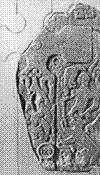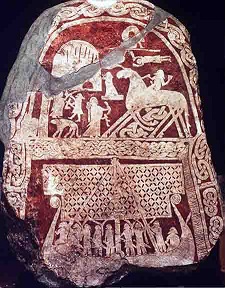|
Odin

Aliases: Godan, Woden, Wuotan
Location: Norway, Sweden, Denmark, Germany, Iceland, England
Cities: Skiringsal, Lejre, Gamla Uppsala
Estimated Date: 500s A.D. - 1200s A.D.
His name is based on the central characteristic of Dionysus worship
The name Odin is related to the word Odr, meaning “frenzied” or “divine madness”, with connotations of both inspiration, song and insanity, bringing to mind the primary qualities of Dionysus. The word Odin, from which the name Wednesday comes from, is derived from the Proto-Indo-European word, *waet, meaning to “fan” flames (of inspiration), the same root as the Latin word vaetes, meaning “seer” or “singer”, and the Celtic faith(not related to the English word faith), meaning “inspire” or “poet”.
His lover is associated with Venus
His consort is believed to originally have been Frijjo, from who is typically identified with both the love goddesses Freyja and Frigg, the latter of whom was connected to Venus by the first century A.D., giving her name to Friday, which had been known as the “day of Venus” throughout many cultures. Plants named after Freyja were eventually renamed after the Virgin Mary.
He is hung on the Tree of Life as a sacrifice to himself, stuck with a spear and refused drink, just like Jesus
Odin’s Rune Song, dated between the 800s and 1200s, tells of how Odin hung himself on the great World Tree, Yggdrasil (“Odin’s Horse”), as a sacrifice to himself, pierced by a spear or lance just as in John 19:34, and is refused drink similar to how Jesus refuses drink in Mark 15:23.
I know that I hung, on a wind-rocked tree, nine whole nights, with a spear wounded, and to Odin offered, myself to myself; on that tree, of which no one knows from what root it springs.
Bread no one gave me, nor a horn of drink, downward I peered, to runes applied myself, wailing learnt them, then fell down thence.

Jesus is portrayed like him being hung on the Tree of Life
A Christian runestone from Jelling, Denmark, in 965 A.D. mimics Odin's crucifixion on Yggdrasil by showing Jesus in a crucifixion posture with branches wrapped around him. The inscription says: “King Haraldr ordered this monument made in memory of Gormr, his father, and in memory of Thyrvé, his mother; that Haraldr who won for himself all of Denmark and Norway and made the Danes Christian.”

Runestone from 965 A.D. of Jesus hung on Yggdrasil like Odin
He is shown next to a cross

Stone fragment from the Isle of Man showing a large cross with panels
including Odin and his raven battling the Fenris wolf at the Norse apocalypse
The serpent on the Tree of Life he is hung on is the Norse version of the Devil
The world tree Yggdrasil also had a serpent, Nidhoggr (“Curse Striker”) gnawing at the root of the World Tree just as the serpent of Eden resided in the Tree of Wisdom. The serpent is portrayed in one story as trapped beneath the tree, much like how Satan is trapped beneath the earth. Another story portrays Nidhoggr as a Satanic creature who punished evil men after they died. In the Poetic Edda, Thor must wade through two rivers to “sit as judge at the ash of Yggdrasil”. A squirrel carries “cursed messages” between Nidhoggr and an eagle that rests on its branches while four stags and Nidhogggr consume the tree from above and below. This “animals-as-holy-tree-parasites” symbolism is identifical to a Sumerian myth, the Myth of the Huluppu Tree, in which the serpent, the Lilith and the Anzu-bird take root in Inanna’s holy Haluppu tree in Uruk, much to the dismay of the goddess, so that the hero Gilgamesh solves her problem by slaying the serpent, scaring off the Lilith and the Anzu-bird, then cutting down the tree to made a bed and chair for Inanna. The story probably represents Sumerian monarchies pushing off “parasitical” foreigners and changing Inanna's tree-religion into a temple-religion, centralizing the profits in the capital city of Uruk, just as the Jerusalem kings Hezekiah and Josiah were said to have cut down the Asherah tree-poles in order to force the local population to sacrifice at the state capital only. In the 12th century B.C. creation myth, the Enuma Elish, the Babylonian war/storm god Bel Marduk likewise slays the Mother of all the Gods, Tiamat, as a mythical precursor to the dragon battles of Ba'al Hadad, Apollo and Yahweh. Thus the serpent totem, which in Iraq goes back to the Ubaid period, was demonized as a foreign parasite and associated with punishment in the afterlife.
He has a holy day on Christmas and he is the real Santa Claus behind St. Nicholas
During Yule, Odin was said to have led a hunting party in the sky that ended on Christmas Eve, or Mōdra-niht, literally “Mother’s Night.” A boar was sacrificed to Freyr. Children set their boots filled with straw, carrots and sugar by the hearth so that Odin’s flying horse, Sleipnir would come and eat the contents and Odin would fill the boots with toys and candy. Odin’s son Thor also rode a chariot pulled by two white goats with the familiar-sounding names Cracker and Gnasher, as well as lived in a palace among icebergs in the “North-Land” (or North Pole), and would come down the chimney into the fire without being harmed. Odin’s ravens, who would listen at the chimneys to learn if the children were naughty or nice, were later replaced by “Zwarte Pieten”, or “Black Pete’s”, Moorish children who reported good and bad deeds to Sinterklaas, later evolving into Santa’s elves. The white-bearded “Father Time” figure of Persian lore, Amoo Nowruz (“Uncle New Day”) also brought gifts, but on the New Year of the Spring Equinox rather than the Winter Solstice. Amoo Nowruz also had a young, soot-faced, red-suited, festive-dancer, and helper named Hajji Firuz, who announced his coming with a tambourine. The twentieth century Iranian linguist and mythologist Mehrdad Bahar suggested the dark face of Hajji Firuz went back to the death of Dumuzi, but this interpretation has been heavily criticized.

Odin riding the eight-legged hors Sleipnir, dated 700s-800s A.D.
The Christmas Tree is based on the Yule log
The burning of the Yule log, which originally was the bottom part of the Christmas tree that was cut off, was said by the 18th-century English historian Henry Bourne to represent the Anglo-Saxon belief in the return of the sun and the increase of days and by famed 18th-century German mythologist Jacob Grimm to have parallels in the South Slavic custom of burning a young tree on Christmas Eve and strewing its ashes on fields or gardens to promote fertility. The Romans also used a fir tree to celebrate the Winter Solstice, Saturnalia, during which time they exchanged gifts and treated slaves as equals or superiors. In Poland, decorated tree branches were suspended on the ceiling of a home to increase the harvest of the New Year. During the Middle Ages, an evergreen “Paradise Tree” was decorated on December 24th for the “Feast of Adam and Eve” but the Christmas tree was first mentioned in Estonia in 1441 in which celebrators danced around the tree and then afterwards burned it. The tree was sometimes identified with Jesus. One story claims that Martin Luther brought in the first Christmas tree in the 1500s, but there is also a story that St. Boniface replaced Thor's Oak with the first Christmas fir tree in the 700s. The story is that he saved a young boy or girl from being sacrificed and then cut down the oak tree as its worshipers stood and looked on and did nothing after which they converted at the sight of tree falling and bursting into four parts. Like St. Nicholas, St. Basil of Caesrea was also given the role of Santa in the Greek tradition. Given that there are at least four Christian figures to provide a mythical origin of Christmas, the best explanation is that these replacement stories were used to cover up the embarrassment of religious syncretism. It has been argued that none of this matters because Christmas and Easter are not in the Bible, but while this may be true for modern Christians whose Greco-Roman heritage is tied to the Biblical canon established by the fourth century bishop Athanasius of Alexandria, Greek or Latin texts certainly would not have mattered as much as religious holy days to illiterate peoples being “converted” through religious syncretism.
The Yule-Clog therefore hath probably been a Part of those Ceremonies which were perform'd that Night's Ceremonies. It seems to have been used, as an Emblem of the return of the Sun, and the lengthening of the Days. For as both December and January were called Guili or Yule, upon Account of the Sun's Returning, and the Increase of the Days; so, I am apt to believe, the Log has had the Name of the Yule-Log, from its being burnt as an Emblem of the returning Sun, and the Increase of its Light and Heat. This was probably the Reason of the custom among the Heathen Saxons; but I cannot think the Observation of it was continued for the same Reason, after Christianity was embraced.
Next God: Baldr
The Dying-and-Rising Gods
Leave Comments Here
|

